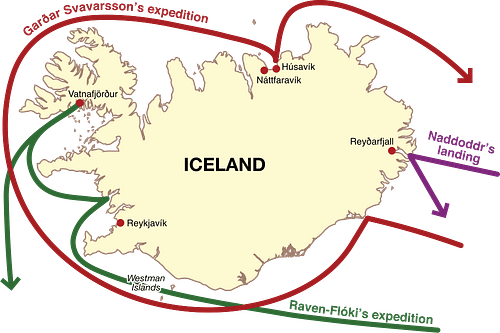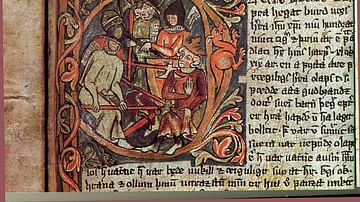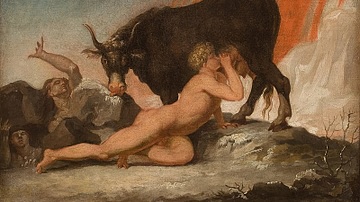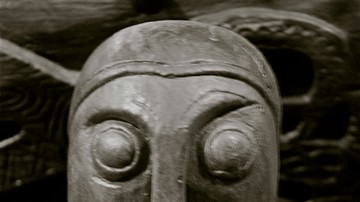It is said that the early Norse settlers of Iceland in the Viking Age (c. 790-1100 CE) believed it was the home of the gods because of the tale of the creation of the world in Norse religion. In the time before time, the story goes, there was only the great misty void of Ginnungagap and the world tree Yggdrasil. On either side of the void emerged the fiery realm of Muspelheim and the icy world of Niflheim. In time, the fires of Muspelheim melted the ice of Niflheim and the giant Ymir and sacred cow Audhumla emerged and, later, so did the gods. Since Iceland's landscape was marked by both ice and fire (in the form of volcanos), it was thought to either be – or at least resemble – the primordial realms from which all life emerged.
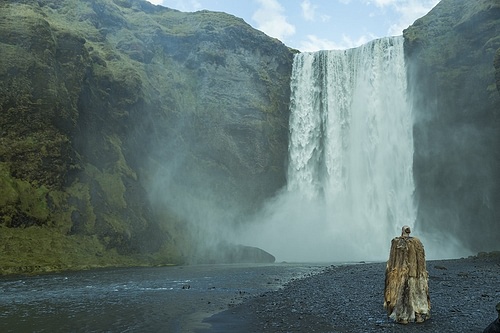
Whether the early settlers actually believed this or whether it is a later insertion by 12th- and 13th century CE scribes from whom we know this story is unknown, but it remains a vital aspect of Icelandic culture even in the modern day. The link between Iceland and the Norse gods forms the basis for the storyline in the TV series Vikings: the character of Floki makes this claim in bringing settlers to Iceland after the gods grant him a vision. As with many of the characters in Vikings who are rooted in legend, Floki is based on the legendary pioneer Flóki Vilgerðarson (also known as Hrafna-Flóki) who was among the first to visit Iceland. The historicity of these early adventurers cannot be confirmed but the later Old Norse sagas have made them, and the land they discovered, famous down through the ages.
Further, the stories told by the poets of the Norse gods, of elves, spirits, dwarves and other entities which inhabited the land, encouraged a respect for the natural world which, though initially ignored in the interests of development, eventually became an integral part of Icelandic culture. The foundation of this respect rested not only on the beauty of the landscape but also on the stories of the great heroes of the past who strode across it and the unseen entities which helped or hindered them.
These stories were passed down orally until the 12th and 13th centuries CE when they were written down and include tales of great heroes and deeds recorded in works such as Grettir's Saga, the Saga of the Volsungs, Saga of Ragnar Lothbrok, the Prose Edda, and the Poetic Edda and tales of the settlement of Iceland. Although scholars believe there is always some historical fact behind these stories, they are considered largely works of legend and myth.
The earliest sources on Icelandic settlement are the Íslendingabók (“Book of the Icelanders”, c. 12th century CE) and the Landnámabók (“Book of the Settlements”, c. 13th century CE). Landnámabók is thought to have been written or compiled sometime in the 9th century CE and the 13th century CE copies now extant are revisions of the original. The Íslendingabók in its final extant form is the work of the great Icelandic historian Ari Thorgilsson (c. 1068-1148 CE) who was working from earlier sources, most notably a now-lost work by Saemund Sigfusson (c. 1056-1133 CE). Aspects of both works are thought to have been transmitted orally at first, especially the stories of the first explorers and settlers, and both contain semi-legendary accounts of Iceland's early days.
The first Pioneers
The first people said to have explored Iceland came from Norway. According to the Landnámabók, the first settler in Iceland was Naddodd the Viking (c. 830 CE) who was sailing from Norway to the Faeroe Islands when he was blown off course. He explored the land, searching for any communities, and found no evidence of human habitation. He then established a settlement on the east coast at the site of present-day Reyðarfjörður but left within a year to return to Norway. Naddodd is claimed to have given the island its first name: Snowland.
Naddodd was followed by Gardar the Swede (also known as Garðarr Svavarsson, c. 860s CE) who may also have been blown off course when he discovered the land. He circumnavigated the landmass and determined it was an island. He also established a small settlement, this one on the shore of the bay of Skjálfandi (modern-day town of Húsavík), in the north. Gardar renamed the land “Gardar's Island” and sailed back home. One of his crew, however, a man named Nattfari, stayed behind with a slave and bondswoman and these were the first permanent settlers in Iceland.
The third Scandinavian explorer to Iceland was Flóki Vilgerðarson (c. 868 CE). Gardar had already established there was a large island worth exploring and Flóki set out to establish a settlement there. He was unsure of the precise location, however, and so brought along three ravens to help him, thus giving him the name he is best known by, Hrafna-Flóki (“Raven Floki”). He released the first but it would not leave the ship and the second one flew away and then swiftly returned; the third raven, however, flew off and led them safely to land.
Scholar Raymond Ian Page, commenting on this story, writes, “the resemblance between this story and that of Noah at the end of the Flood is unlikely to be coincidence and, at least in this form, must be highly suspect.” (61). This event, as others like it in both works, give them their mythical quality and distance them from authentic histories.
However that may be, Flóki is claimed to have stayed the longest of the early explorers and to have established a community on the Borgarfjord (Borgarfjörður, on which lies the modern-day town of Borgarnes) on the west coast. Flóki and his crew found a plentiful food supply by fishing and so neglected to plant a crop to feed the livestock they had brought with them, resulting in the death of all the animals. Page notes how this motif of the death of livestock is often repeated in accounts of early Norse explorations and should also be interpreted cautiously as actual history (61).
Flóki was forced to stay far longer than he had planned due to ice blocking the fjord he needed to sail out of and, in his frustration at being trapped, he named the place “Iceland”. When he returned to Norway, he had nothing good to say about where he had been but two of his crew – Herjolf and Thorolf – praised it highly. This sparked interest in further migration because arable land in Norway was scarce at that time and high taxes made the idea of relocating quite attractive. Even though Thorolf had described the land as so beautiful butter dripped from the grass, and many were interested in going there, the name “Iceland” stuck.
The Early Settlers
The Landnámabók goes into detail on the expedition of the man considered the first historical settler of Iceland, Ingólfr Arnarson (c. 874 CE). Ingólfr and his foster-brother Hjörleifr had initiated a blood-feud in Norway and left for Iceland. They liked the land but found they did not have provisions enough to establish a settlement and so returned home. Ingólfr then raised money and gathered volunteers to return while Hjörleifr resorted to the tried and true Viking method of raising capital by raiding in Ireland where he made off with a considerable amount of treasure and ten slaves.
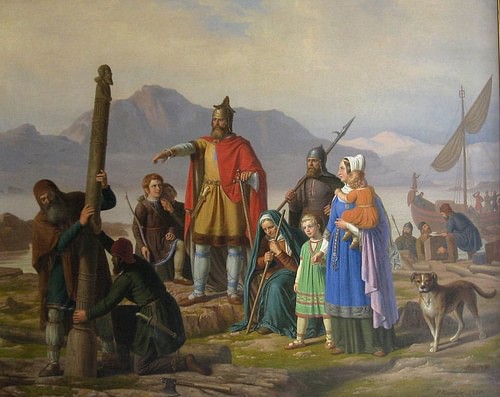
Ingólfr is described as a pious man who feared the gods and made daily consultations with and sacrifices to them while Hjörleifr ignored the gods and relied on his own reasoning and skills to navigate life. Ingólfr, accordingly, asked the gods if it was their will he should return to Iceland and was given a positive sign. He and Hjörleifr set sail in separate ships and traveled together until they were parted – or agreed to part – just off the coast of Iceland.
In keeping with tradition, Ingólfr threw his high-seat pillars (pillars of wood) into the sea knowing that wherever they washed up on shore would be the place the god favored for the settlement. Hjörleifr had no regard for this custom and sailed up the coast until he found land that seemed good and then put ashore. He and his men established a settlement at Hjörleifr's Head (modern-day Hjörleifshöfði Promontory). Ingólfr, meanwhile, went ashore, built a temporary shelter, and sent his slaves out to search for the place where his pillars had washed up.
At Hjörleifr's settlement, one of the slaves he had taken from Ireland, Dufthak, suggested to the others that they kill the community's ox, tell Hjörleifr and his men it had been killed by a bear, and then when they were all out hunting the bear, the slaves could kill them one-by-one. This plan was agreed to and, when Hjörleifr and his men fanned out into the woods in search of the bear, they were all killed one after the other. The slaves then took the women of the settlement and all the provisions and sailed to the western isles near the coast.

Ingólfr's slaves were still looking for the pillars when they came to Hjörleifr's settlement and found all the men dead and the slaves and women gone. They reported this back to Ingólfr who arranged for his foster-brother's burial and then hunted down the slaves and killed them all; those who did not die by his hand were killed fleeing from him and falling off a cliff. Ingólfr interpreted Hjörleifr's fate as being the natural outcome of a life spent disrespecting the gods. Once his foster-brother had been avenged, Ingólfr returned to his settlement and learned that his slaves had located the pillars and so founded his permanent community at that spot – modern-day Reykjavík – in 874 CE.
Although this story also has semi-legendary elements (most notably the difference in piety of the two main characters and their ultimate fates), it is still considered historical based on corroborating evidence. The Landnámabók lists in detail all of the early settlers in Iceland from Ingólfr's expedition and archaeological and genealogical evidence supports the historicity of these land-settlements in 874 CE and afterwards, with the majority of arable land being settled by c. 930 CE.
The Indigenous Population
Although there were no human beings in Iceland when the early pioneers arrived (though there were said to be Irish monks living there when Ingolfr and his party arrived), legend claims that the island was populated. Dwarves, elves, fairies, trolls, sprites, and land spirits were thought to live throughout the land and care had to be taken not to disturb or enrage them. These tales of supernatural beings were passed down orally, as noted, until the 12th- and 13th centuries CE when writers like the Icelandic mythographer Snorri Sturluson (1179-1241 CE) wrote them down and edited them for a new audience.
In the nine realms of Norse cosmology, the dwarves lived in Nidavellir/Svartalfheim beneath the earth. They were magical beings responsible for the creation of Mjollnir, Thor's hammer, and Gungnir, Odin's spear. Dwarves were thought to have formed like maggots from the corpse of the giant Ymir at the beginning of the world and, although they served an important function for the gods in the creation of magical objects, were primarily associated with mischief and were best avoided. Dwarves represent the unseen forces of creation which one must be wary of.
The same is true of the elves – known in Iceland as huldufólk (“hidden people”) – but in a different way. The elves were said to live originally in the realm of Alfheim in the roots of the world tree Yggdrasil but, on earth, they live in rocks and cliffs. Although they also symbolize the mysterious and unseen aspects of the world, they are considered far more benevolent than the dwarves and ask only to be treated with the same kind of respect they show to others.
Belief in elves is still so prevalent in Iceland today that plans for building projects and roadways have been changed to accommodate them. To cite only one example, a proposed road that would have damaged or destroyed a 70-ton rock formation was halted in 2014 CE because the rock was claimed to be an elf chapel. The project could only proceed once the formation had been relocated intact to another area the elves approved of (Kirby, 2).

Belief in the hidden people as well as in other invisible entities has a long history in Iceland because the landscape itself encourages it and because of the respect for story-telling in Scandinavian culture. As noted, the original settlers are said to have believed Iceland was the land of the gods and was imbued with spirits. Regarding this, Professor Aðalheiður Guðmundsdóttir notes, “You can't live in this landscape and not believe in a force greater than you.” (Kirby, 3).
The landscape, however, has long been linked to numinous forces through the power of legends, folklore, and myth embedded in Iceland's culture by the skalds (poets) who arrived with the early settlers. The poet had a respected position in Norse culture, as they were closely associated with scholarship and their stories provided the Norse with their world view. Scholar Robert Carlson notes:
Originally the sagas were retold by the elders of the community or the professional Skalds as they traveled around the country. The setting for these tales to be told could be the warm, family longhouse on a bitterly cold, long winter night or the splendiferous banquet hall of a great king. This storytelling was taken very seriously as it commemorated and extended the history of the various tribes and instilled the necessary faith and proper goals to strive for among the young. (26)
Elves and other beings came naturally to life through these stories which the early settlers wove around the pristine landscape they found on their arrival.
Conclusion
Descriptions of early Iceland in the sagas present a version of paradise with abundant game and fish and forests which stretched down long slopes and covered valleys which, besides being home to wildlife, was also inhabited by the elves and other spirits. The landscape quickly changed as trees were cut for timber and in order to clear the land for homes and pastures. Scholar Sveinbjörn Rafnsson quotes from Ari Thorgilsson's 12th-century CE work, writing, “Ari's comment that when the first settlers reached Iceland it 'was grown with wood between mountains and shores' implies that in his own day this woodland had been significantly reduced.” (Sawyer, 120).
The wildlife population also steadily decreased as it became prey to hunters. The great auk, a type of penguin now extinct, is thought to have once populated the island and it is clear from literary and archaeological evidence that various birds, reindeer, seals, whales, and walruses were regularly hunted to the verge of extinction.
Once the land was cleared, there was nothing to protect it from the scouring winds which increased natural erosion, especially inland. Iceland then followed the same sort of pattern evident in other cultures of having to acclimate to the environment they had created. In some civilizations, such as that of the Maya or the great cities of Mesopotamia, the challenge was too great and the land or cities were abandoned. In Iceland, the people were able to adapt and the modern-day belief in elves, no matter the percentage of believers, is evidence of this. Icelanders learned from the mistakes of their ancestors and preserve their environment today by respecting the landscape as a living habitat of unseen forces.
